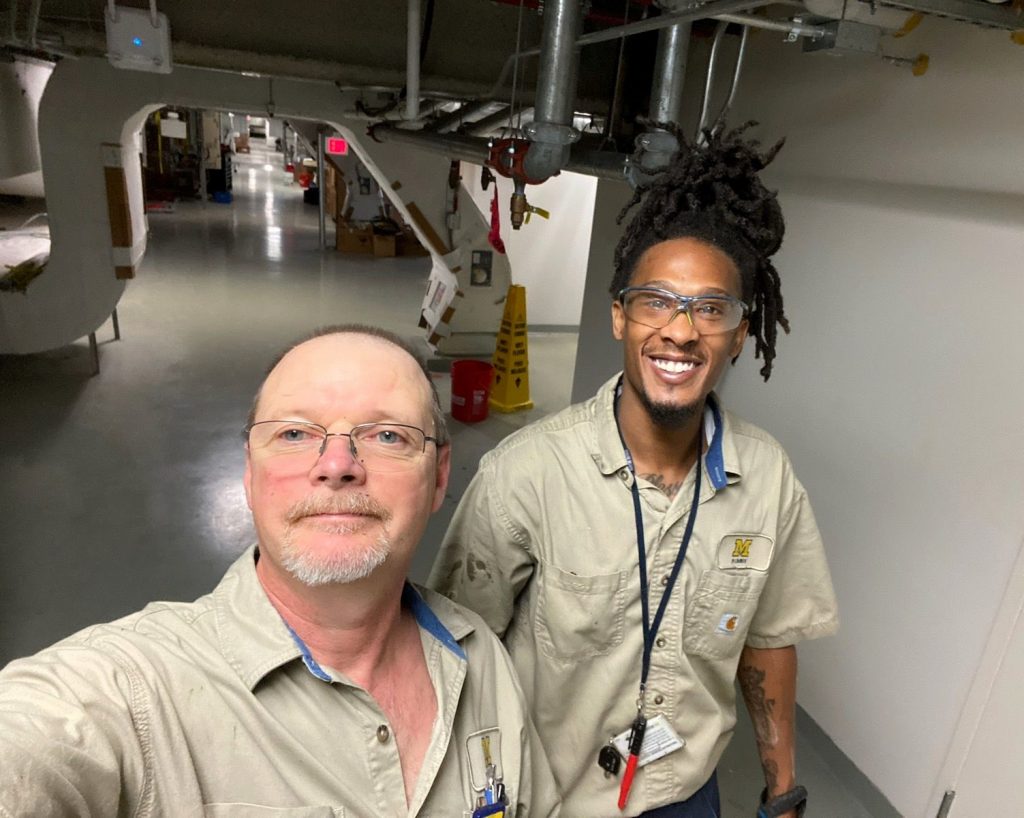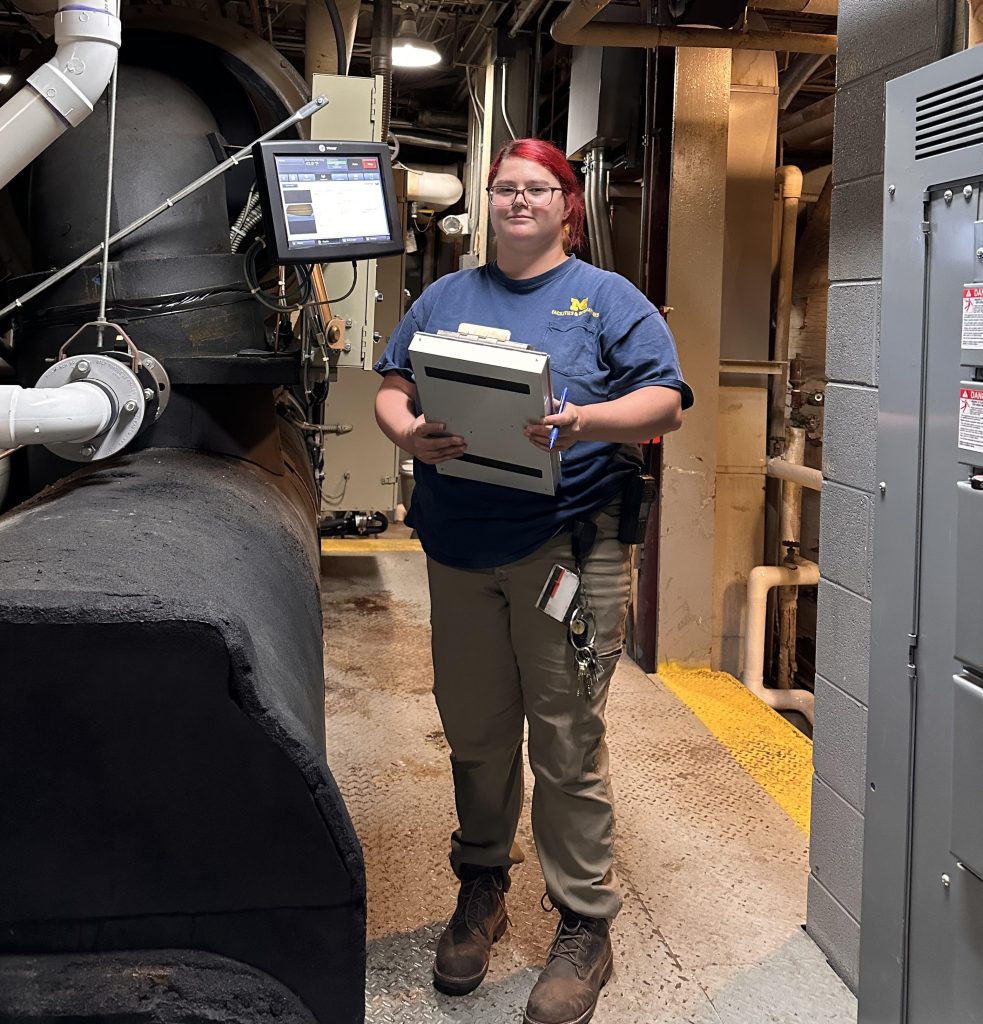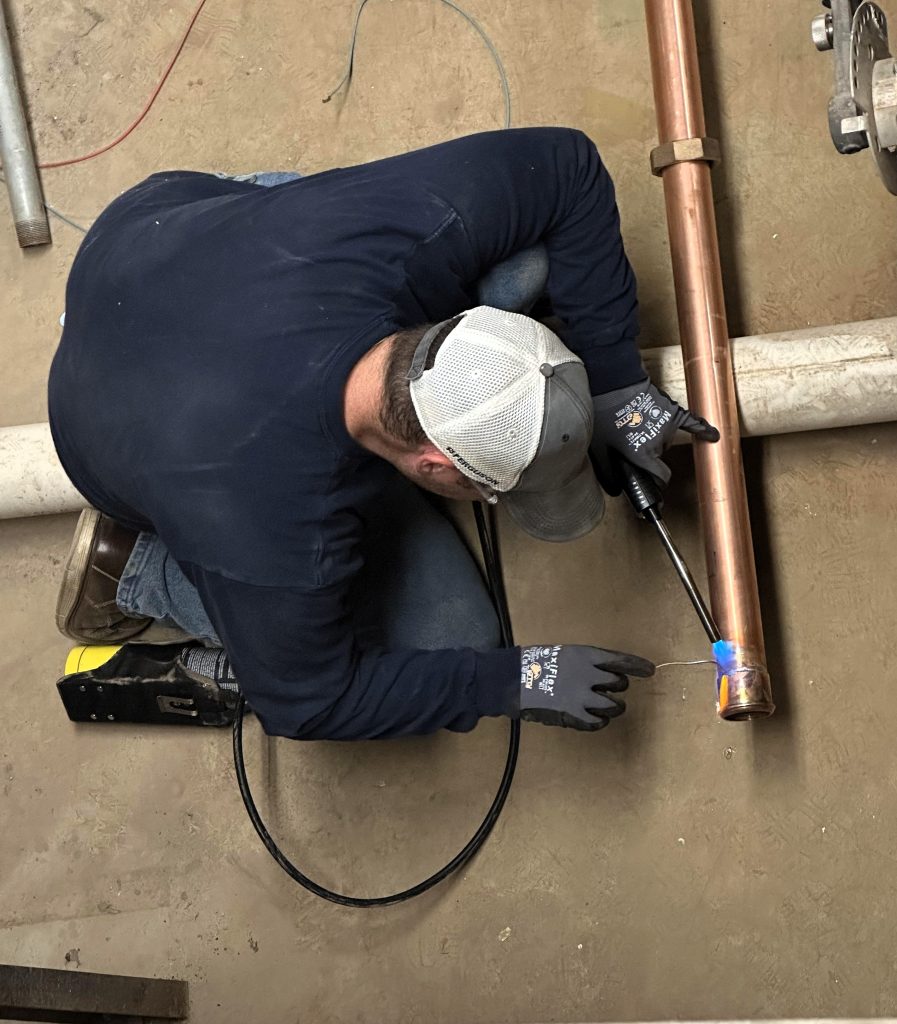“I’m always willing to learn new things.” Quinten Francois, a plumbing apprentice at Michigan Medicine, put into words the mindset intrinsic to becoming an apprentice.
A trades apprenticeship requires 5 years of on-the-job training and a rigorous course of study after hours, so a commitment to learning and hard work is crucial.
The U-M Skilled Trades Apprenticeship Program gives staff an opportunity to become skilled tradespeople, while also bringing new people into a field where many workers are reaching retirement age. Nine apprentices were hired this year, joining 9 hired last year.

While Quinten Francois (right) was working in retail and landscaping, he had his first son and “wanted a career. I didn’t want to keep having jobs. I wanted a place where I could be an asset to an establishment.” So he took a pay cut to become a custodian at U-M and soon after took a maintenance mechanic position through the Employees Working out of Classification (EWOC) training program.
“I was trying to get into an apprenticeship but didn’t know how, just that I needed to put myself out there and start learning,” Quinten said. “I’m always willing to learn new things even if it wasn’t my job. A lot of people think ‘I don’t get paid for that.’ I look at it as ‘I can pay myself in knowledge.’”
Quinten is proud to be setting a good example for his sons, ages 6 and 9. “They can see where I started and where I’m at now. They also see how much happier I am while working at the university. I’ll be the first-generation plumber in my family.”
HVAC apprentice Katelyn Sowle also took the custodian to maintenance mechanic route to becoming an apprentice, but in her case, it’s a family affair. Her dad was a fire alarm electrician at U-M. Her older sister is a maintenance mechanic at the hospital and her brother just became an elevator apprentice. “We all came here as custodians and worked our way up. All of us looked up to our dad and knew that U-M was the place to go!”
Kateyln grew up fixing things with her dad. “I enjoyed working with someone else to fix things, and the collaborative ideas you’d develop together.” So after trying out college for a bit, she reflected that she preferred working with her hands and that her dad “found a better way of life without fully going through college.” So she came to U-M as a temporary custodian, got hired as a permanent custodian after 6 months, then became an EWOC maintenance mechanic.
One thing Katelyn—and other apprentices—especially likes about having a practical hands-on job is how useful it is in her personal life. She was drawn to the HVAC field because doing preventive maintenance on air handlers was one of her favorite tasks as a mechanic. Now she finds that “An air handler is just a fraction of what HVAC entails.” She says what she learns will be “helpful with my family’s stuff because I’m sure they’re going to ask me to help a lot!”


Nick Stull, a plumbing apprentice, also entered the trades inspired by his dad, a plumber pipefitter. First Nick served in the military, then became a maintenance mechanic at the hospital. “At the hospital, different trades all work together, so I got to work with different roles and found I liked plumbing.”
Sure enough, “When I got into my apprenticeship, I realized I love it. I love being able to weld, braze, and solder. Plumbing is not just putting a toilet into somebody’s house.”
A recent job bears this out. Nick and his colleagues replaced a significant section of plumbing at Kellogg Eye Center. They replaced pipes all the way from the ground floor up to the mechanical room, which required wearing a harness and climbing 100 feet up a scaffold. “I hate heights but you gotta get over it and do it. It’s cool! As much as it scares me to be up that high, what if we never do a job like this again and I never got to experience it?”
Between the novelty of doing different work in different places all the time and job security (“we’re always going to need plumbing”), Nick finds his apprenticeship to be a great fit for his long-term goals. “I want to have an advanced knowledge of the job to where people ask me ‘I need help with this job’ or “I remember you had a trick for this, can you show me?’ I’ll retire here, as long as they’ll let me!”
Beyond Quinten, Katelyn, and Nick, the other 2023 apprentices include 2 more HVAC mechanics, 1 elevator mechanic, and 1 fire alarm electrician in F&O. Michigan Medicine hired 1 electrician and 1 industrial electrician.
The skilled trades apprenticeship program is registered with the Department of Labor, which certifies it meets national apprenticeship standards. The Joint Apprenticeship Committee, which consists of elected Skilled Trades representatives and management representatives, manages this university-wide program with support from F&O Training and F&O Human Resources.
Written by Katrina Folsom

